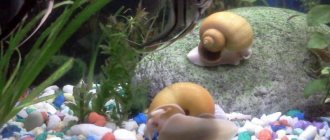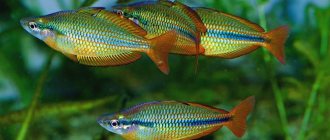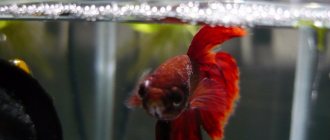Quickly navigate to the article
- 1 Which aquariums are considered small?
- 2 Caring for a mini aquarium
- 3 Small aquarium and equipment for it
- 4 Filter
- 5 Lighting
- 6 What kind of fish is suitable for a mini aquarium?
- 7 We carefully study the compatibility of species 7.1 PLANTS IN A MINI AQUARIUM
- 7.2 FEEDING
- 8.1 Other interesting articles
A small aquarium is a tank with dimensions of 20x40 cm or less (nano aquarium), in which you can place small ornamental fish. The volume of such containers can be from 10 to 20 cubic liters, so they are suitable for installing decorations and equipment. In a small aquarium you need to install lighting, plant plants, decor, and don’t forget about the filter and compressor. That is, a small aquarium should not differ in functionality from a spacious one.
What aquariums are considered small?
Aquariums with a volume of less than 30-40 liters are considered small, usually from 5 to 20 liters. They are often called nano aquariums (from the Greek nano - “small, tiny, dwarf”), emphasizing with this term not only their size, but also their modernity and manufacturability. There are also microaquariums, their capacity is 1-2 liters, and animals are not allowed in them, with the exception of some types of snails. The world's smallest fish aquarium was created by Omsk miniaturist Anatoly Konenko and his son Stanislav. They placed soil, a specially designed mini-compressor, small Cladophora bushes and several zebrafish fry in 10 ml of water.
Let’s immediately agree that we will not call a round ten-liter jar with a goldfish a nano aquarium, since this is not an aquarium, but a mockery of fish and all the principles of aquarium management. <An aquarium, no matter what size it is, is an equilibrium biological system whose inhabitants feel comfortable.
Achieving this in a small volume is a whole science. But if this is successful, the results can be simply amazing. Such aquariums, where a living biotope is reproduced in a tiny volume, are reminiscent of the Japanese art of bonsai or scale models of luxury cars: small, but everything is real.
Of course, not all small aquariums are worthy of aquascaping competitions or books of records, but any of them should please the eye of its owner and create a comfortable environment for its inhabitants.
High fin shark catfish
The high-fin shark catfish is native to Southeast Asia. What is noteworthy is that this fish has nothing to do with sharks, although the similarity is striking.
In nature, shark catfish reach large sizes, but aquarium species, as a rule, do not reach a length of 50 centimeters. The high-fin shark catfish has a rather calm character, but this is only the case while the fish is well-fed. And in a hungry state, they attack everything that can fit into their mouths. Those fish that cannot fit in the mouth do not evoke any emotions in shark catfish. They will never try to tear a piece off a victim, as real sharks do.
The shark catfish is an aquarium resident that has nothing in common with sharks.
High-finned shark catfish can be kept with motoro rays and red parrots.
Mini aquarium care
As for keeping a small aquarium, here you can fall under the influence of stereotypes. Parents often buy aquariums for their children, believing that a small aquarium is easier to care for than a large one. Rather, on the contrary, the “underwater world” of a small size is subject to temperature changes and requires frequent water changes.
If the water is changed rarely, fish waste products begin to accumulate on the walls and it will be quite difficult to clean the container with your hands. In addition, the slightest excess of food lying at the bottom of such an aquarium instantly spoils the water and shifts the biological balance. But if you decide to have a small aquarium, buy it “fully equipped”. Specialists will select all the necessary equipment for lighting, water filtration and water heating. And, despite the equipment, place the aquarium in a room where the temperature is constant.
With such a small amount of water, a difference of even 1-2 degrees has a negative effect on the fish. When feeding your fish, allocate a small amount of food so that there is no leftover after feeding. Remove excess feed immediately. When caring for an aquarium, you will have to change the water frequently until the bacteria stabilize in the filter.
Bacteria convert waste decomposition products into harmless substances. A supply of settled water should always be at your disposal. The water in the aquarium should be changed every three to four days, replacing at least a quarter of the volume of water in a small aquarium.
To prevent the appearance of algae, the aquarium should not be placed close to a window. Direct sunlight should not fall on it, and it is advisable to gradually increase the duration of active daylight hours from six hours immediately after setting up the aquarium to ten hours by the time the biological balance has stabilized.
Choosing a room for a fish house
Hallway
A very interesting idea, which requires additional light when implemented in order to create an artificial change of day and night for the fish if there are no windows in the hallway. In addition, you need to install it away from the door, avoiding drafts.
Living room
Placing an aquarium in this room is a traditional interior design technique. If you build it into the wall, thus separating the hallway from the living room, the effectiveness of the interior is guaranteed. But you need to maintain the proportions of the sizes of the living room and the aquarium.
Kitchen or dining room
If the kitchen is small or medium-sized, there is absolutely no point in placing an aquarium in it. Temperature changes and other non-charitable factors are not the best place for breeding fish. Such an installation is permissible only in large spaces or in remodeled kitchens that smoothly transition into dining rooms - a kitchen-studio.
Bedroom
Before installing an aquarium in your bedroom, consider how light of a sleeper you are. An integral part of the aquatic system, filters and compressors can make sounds that will prevent you from falling asleep. Take a good look at the market for silent aquarium models; if, with the help of specialists, minimizing the noise of devices, relaxation and a romantic mood in the bedroom will be guaranteed for a long time.
Children's
Small aqua systems with non-capricious inhabitants or modern models of aquariums without fish will fit very well into a room with kids. This setup will help kids explore the underwater world visually and will serve as an additional function as a soft night light.
Office In this room, aquarium systems are usually installed by true fans of the underwater world. A large vessel with large exotic inhabitants will emphasize the strong character of the owner. You can also arrange the opposite, soft decor in an aquarium with mixed species of fish, this will relax and distract from pressing problems.
Bathroom Aquariums without fish are usually placed in the bathroom, since the lack of daylight can harm their health. To make the aqua system more interesting, multi-color lighting is used. Such “fishless options” are decorated with sea stones, souvenirs and artificial plants. This beauty can be decorated in the shape of a shell - a very original approach.
Small aquarium and equipment for it
Nanoaquariums have a rectangular, cubic or similar shape. They are usually covered with a transparent cover glass, which allows them to be admired from above. They are located away from drafts and direct sunlight and closer to the outlet that will be needed to connect the equipment.
The equipment for nano aquariums is generally the same as for large aquariums, that is, a filter (in some cases a pump with an aerator is sufficient), lighting fixtures, a heater if necessary, preferably complete with a thermostat, and a carbon dioxide supply system.
For those who do not have the experience and time to select aquarium equipment, fully equipped nanoaquariums are available for sale. The Aqua El Shrim Set and Dennerle Nano Cube series complexes are recognized as the best in terms of price and quality ratio.
And if you want to save money or are interested in choosing all the filling for your nanocube yourself, there is plenty to choose from.
Now about the benefits
An aquarium is able to create a calm, relaxed atmosphere in the room, which is the best way to relax and is simply necessary if there are children, stressed people and the elderly in the house.
Water from the aquarium helps to humidify the air in the room, which is very useful for people prone to respiratory diseases, especially in winter, when the air is unnaturally dry.
An aquarium will be a wonderful addition to any interior, especially if it is decorated correctly and the lighting is selected.
Everyone knows that children need to communicate with animals, but it is not always possible to have them in the apartment. And caring for an aquarium is easy and interesting. And even if the child forgets to feed the fish every day, nothing bad will happen.
Filter
For a small aquarium, a filter is vital. Since the balance in this system is very fragile, and a small deviation in the parameters of aquarium water can be fatal for its inhabitants, it is necessary to reduce the risk of these fluctuations as much as possible. Therefore, pumps without a sponge or with a small sponge the size of a matchbox are not suitable. Or rather, they can be used, but only in aquariums with a very large number of living plants and without fish, with only invertebrates. However, with such a population, you can do without a filter at all or limit yourself to a compressor.
If there are fish in the aquarium, the requirements for the filter are very serious. It should have a large filler surface to create biofiltration, pass 8-15 aquarium volumes per hour, but not create strong flows of water that will damage plants, fish and crustaceans. In addition, small inhabitants of the aquarium should not enter its water intakes. And, of course, it should take up minimal space in the aquarium or be well decorated and fit into the landscape. Another optional, but very desirable condition is that the filter material should be removed from the water for rinsing without dismantling the filter itself; this greatly facilitates maintenance of the aquarium.
The following types of filters partially or fully satisfy these conditions:
- Internal filters with open sponges. They do not have a body, therefore, no one will be sucked into them. A large sponge (it is better to immediately replace it with a finely porous one) serves as a good material for mechanical cleaning and a substrate for the growth of biofilter bacteria. Some models of such filters can be placed with the sponge facing up, so it can be easily removed.
- External mounted waterfall filters. They take up little space, since the main part is located outside. They have a fairly large volume that can be filled with various filter materials. They do not create a strong current. The disadvantages are that when using these filters the aquarium cannot be closed with a lid. A sponge or fine mesh must be placed on the water intake tube of such a filter to avoid aquarium inhabitants being sucked into the filter.
- External canister filters. Currently, models designed for small volumes have appeared. Provide very good mechanical and biological filtration without taking up space in the aquarium. As with mounted filters, the water intake tube must be covered with a sponge or mesh. The only drawback is the high cost.
In addition to these models, in small-volume aquariums you can use various home-made designs - airlifts, Hamburg filters, plastic bottles with a fibrous or porous substance connected to a pump. There is only one requirement: water under pressure must pass through a sufficient volume of material that provides mechanical filtration and can serve as a substrate for bacteria participating in the nitrogen cycle.
An additional filter in a small aquarium is live plants, sometimes they are even placed in a hanging waterfall, making it a phytofilter.
A thematic selection of games and exercises for young children on the theme “Fish”
Author of the lesson: Davydova Svetlana Alekseevna.
Goals:
Continue to enrich children's experience when acting with objects of different sizes and colors (yellow, blue, green, red). Teach children to count to two. To develop knowledge about the concepts of “circle”, “one-many” and methods of equalizing populations. Using an experimentation situation, introduce the properties of objects: “floats”, “sinks”. Develop memory, fine and gross motor skills, coordination of movements.
Equipment:
Fish toys of different colors and sizes. Blue cardboard circles. Pebbles. A bowl of water, a bowl of millet. Picture “Fish” for finger painting, finger paints. Picture “Aquarium”, glue stick, paper silhouette of a fish, plasticine. A picture depicting a lake with one fish and a lake with several fish. Card with the image of the number "1". A blank picture depicting a lake and one fish, adhesive pencils, color silhouette images of fish. A background picture depicting large and small fish of different colors with circles of the corresponding color and size pasted on them. Buttons of the appropriate color and size (large and small green, yellow, red, blue, white). A blank picture depicting an aquarium, green and brown pencils, plasticine, a stick. Hoops in yellow, green and red colors. The hoops are blue, with circles cut out of transparent oilcloth underneath them. A fish tied to a string. Trays with semolina. Audio recording: P. Tchaikovsky “Fishes” (from “Children’s Album”), song “About the Fishes”.
Lighting
Due to the mandatory presence of living plants, the issue of lighting a small aquarium becomes relevant. There, lamps built into the lid are almost never used; the lamps are installed at a certain height above the aquarium. Fluorescent or LED lamps are usually used. In general, the rule is this: if the lamps are fluorescent, then for unpretentious plants the light should be 0.5 W per liter of water, for fastidious ground cover or those with a reddish tint - 1 W per liter. If the lamps are LED, then the ratio of lamp power and luminous flux is different, and here they already look at the number of lumens. For undemanding plants, illumination of 25 lm per liter is sufficient, for demanding plants - 50 lm.
Fosters caring
An aquarium will help a child become kinder, love nature, and realize its value. This is called environmental education. An aquarium turns from an interior decoration into a living environmental aid, and a very useful one at that. This hobby also develops observation skills in children. By watching the underwater world, kids learn to be attentive.
A children's aquarium is one of the best ways to create a living corner for a child. It is not as difficult to care for as a dog or cat, although it does require responsibility. If installed correctly, the aquarium will not create unnecessary difficulties. And it will not cause allergic reactions and will not bring infection into the house. If you were still in doubt about whether to buy your child an aquarium, now there should be no doubt left.
Found a violation? Report content
What kind of fish is suitable for a mini aquarium?
Pets with miniature body sizes should be placed in a small 10-20 liter tank. Fish 2-6 centimeters in length will tolerate this volume of water. But remember that even small fish want to swim in a spacious environment. They should not be kept in containers that will restrict movement. Territorial and aggressive fish should not be placed in mini aquariums. Which ones should not be placed in 10-liter aquariums? These are swordtails, medium-sized barbs, cichlids, gourami, and zebrafish. They have an active and energetic disposition and require more hiding space.
In an aquarium of 10-20 liters you can put small barbs, Gertrude pseudomugil, rice fish, cherry barbs, rasbor, erythrozonus, neon, Amanda tetra. You can also keep the following fish and shrimp there: otocinclus catfish, corydoras, amano shrimp, cherry shrimp, copper tetra. Representatives of the genus Poeciliaceae, viviparous fish, get along well in mini tanks.
You need to buy fish breeds with strong immunity, that is, not purebred fish, but hybrids. If you do not have the opportunity to buy a spacious “house” for your small pet, you need to buy a small aquarium with a capacity of 10 liters. The well-known Siamese cockerels are also often housed there. The cockerel can live alone and does not get along with its relatives; it is a fighting fish, after all.
Protopterus
Protopterus are African relatives of the lepidosirenes, but they have a nastier character.
In the wild, these predators can reach a length of 1 meter. At the same time, fish do not tolerate the presence of their own kind and want to live alone in the aquarium. At night they catch small fish and eat them.
Protopterus have external gills, but this does not mean that these fish, like the larvae of Spanish newts, can live in dirty water with high oxidation and a high content of nitrites. Maybe in Africa such conditions are suitable for them, but not in an aquarium. Here you will need to control hydrochemical indicators.
Protopteria is a finicky aquarium fish.
If the flow in the aquarium is insufficient, the protopterus will immediately refuse to eat. Under unfavorable conditions, young individuals quickly die. Can this species be considered an aquarium fish? If you provide your pets with the necessary conditions, then yes, it can.
We carefully study the compatibility of species
Fish for a small aquarium should be selected depending on many factors. For beginners, it is problematic to take them into account on your own, so contact professionals who will help you determine which fish can be kept together and which ones should be avoided.
Factors important when moving in:
- Ability to survive alone. Some species can only live in flocks, so pay attention to this point first;
- Water characteristics for species should be approximately the same;
- The peaceful nature of the inhabitants;
- The number of individuals depends on the surface area of the water. The larger the footage, the more fish you can have;
- Breed compatibility. Sometimes individually peaceful fish cannot tolerate each other's proximity.
It is important to remember that small aquariums are a high-risk area for fish. Therefore, the choice of neighbors will completely determine the fate of your charges. If you add predatory fish to a small aquarium, they will eat their peace-loving neighbors. Gouras are suitable for angelfish; other fish will not get along with them. You can get one fish that will be the owner of your pond, or keep a whole flock of miniature fish.
PLANTS IN A MINI AQUARIUM
Live plants are needed in small aquariums, as they help remove dangerous substances from the water - nitrites, nitrates and ammonia. Plants in a mini-aquarium provide additional insurance and reduce stress in fish. They are also very convenient for growing some small species of plants, because in a mini-aquarium it is easier to create good lighting, but in large ones the light simply does not reach the lower level in the required quantities.
To choose the right plants for your aquarium, read materials on the Internet and talk to experienced sellers, they will always help.
FEEDING
The most important point. The food you feed is the main source, and in some cases even the only one, of various breakdown products. The less you feed, the less dirt and the more stable the aquarium. Of course, the fish must be well-fed, and your task is to maintain a balance between well-fed fish and overfed fish.
A good way is to give as much food as the fish eat in a minute, so that none of the food falls to the bottom. Commercial fish food, in the form of flakes, is a good choice for a small aquarium, it sinks slowly and produces less waste, but also produces small waste and they do not need to be fed excessively. It is better to feed the fish in a new aquarium with it. When the balance is established, or you have bottom-dwelling fish, such as catfish, you can add other types of food for a complete diet.
Pets - aquarium fish for children
There comes a time when every child asks to have some kind of pet. Today we’ll talk about aquarium fish. Are such pets suitable for children? Aquarium fish are a great option for any family. Fish do not require much attention from pets. They are calm, unpretentious, beautiful, and most importantly, quiet home dwellers.
If you don’t have an aquarium yet, then this is an ideal gift option for a child of any age. Even a crawling toddler will enjoy looking at the bright and colorful fish that are always scurrying about. A three-year-old child will already be able to feed his pets independently. Older children will be happy to help their parents change the water in the aquarium and clean it.
Aquarium fish are perfect as a calming agent for easily excitable and restless toddlers (as well as for adults). Watching the fish together is a way to spend time together and relax at the same time.
And now some advice for novice fish lovers
The larger the aquarium, the oddly enough, the easier it is to care for. Therefore, if you yourself decide to buy an aquarium for your child, and did not receive it as a gift, it is better to purchase a capacity of 60-100 liters. The aquarium should be positioned so that direct sunlight does not fall on it - this can lead to “blooming” of your pond. Also, residents of aquariums are afraid of drafts and heating appliances. For such a voluminous aquarium, you need an appropriate stand: a cabinet or table, the main thing is that it can withstand the weight. Don’t rush into buying fish; first you need to prepare a home for them, so to speak.
Pour soil into the bottom of the container, plant plants, place various figures (a sunken ship or a beautiful amphora), and then carefully fill with cold tap water. IMPORTANT! Let the water sit for a week and during this time the aquarium will form its own microflora. For an aquarium, in addition to fish and decorations, you will need to purchase lighting and a filter. Fish need light for only a third of the day, so do not forget to turn the light bulb on and off, and it is advisable to do this at the same time, like day and night :) Choose a filter, taking into account the volume of the aquarium, and it should work continuously. That is, you turn it off You will only have it for the duration of the service. Maintaining an aquarium may seem difficult at first glance, but once you make it a habit, it will take very little time and effort. To care for the aquarium you will need: a special vacuum cleaner, but essentially just a vacuum tube (or a large rubber bulb) and a scraper for cleaning glass. Cleaning a 60-100 liter aquarium once a week is enough
Cleaning such an aquarium is as follows: wash the filter once a week and clean the soil of biological waste using a vacuum cleaner or blower. During one cleaning process, no more than 15-20% of the water in the aquarium should be changed. The settled water should be added to the previous volume. The glass in the aquarium should not be cleaned weekly, but as it gets dirty.
An aquarium with a smaller volume is much more difficult to clean. You need to remove the fish from the aquarium using a net, wash the soil, wash the aquarium itself, pour in settled water and only then return the fish.
To choose fish, go to the bird market. There you will clearly see the color, size and degree of mobility of your future pets. All fish are different and you need to take into account that some are nocturnal or sedentary, and since we are buying fish for a child, such pets are not suitable for us. Also keep in mind that if you purchase at least one predatory fish, the rest of the inhabitants of the aquarium may suffer, so when buying different fish, ask the seller whether the neighbors will get along together.
We have had an aquarium at home for several years. Therefore, I can tell you both the pros and cons of such pets, so to speak, first hand.
Pros of aquarium fish
- You don’t need to walk the fish in any weather 3 times a day
- You can feed the fish once a day, and even a 3-year-old child can handle it.
- Fishes relax and calm
- A skillfully organized aquarium can become an excellent element of the interior of your home.
Cons of aquarium fish
- When buying an aquarium and fish you will have to fork out a little
- You cannot pick up a fish, stroke it or walk with it.
- If poorly cared for, fish may die
- Dry fish food can cause allergies in both children and adults
Now it’s up to you to decide whether pets such as aquarium fish are suitable for you and your children.
Decorating a small aquarium
You can decorate a nanoaquarium in different styles. Popular among aqua designers are the styles of iwagumi—decorated with stones of various shapes, rayuboku—decorated with driftwood, and wabikus—in the form of a hummock with plants. But here the taste and preferences of the owner are decisive. For example, if an aquarium is in a child’s room, it is quite appropriate to place a mermaid’s castle or a sunken ship and toy scuba divers in it. The main thing is that the decorations do not take up too much space (as a general rule, no more than a quarter of the bottom surface and half the height), hide the aquarium equipment and leave room for plants and fish. In addition, if there are shrimp in the aquarium, you must keep in mind that any objects protruding from the water can contribute to their escape from the aquarium.
The soil in small aquariums is usually used in two layers: the bottom layer is a nutrient substrate, the top layer is gravel, the total thickness of the layer should be 3-4 cm.
Other interesting articles
- What fish can live without aeration, air in the aquarium? What fish can survive without oxygen and filtration? No living creature can live without...
- Does loud music affect fish in an aquarium? Aquarium fish are rightfully considered one of the most delicate and vulnerable pets. Their calm...
- Astronotus with whom can live in the same aquarium Astronotus is a bright and predatory representative of the cichlid family, whose appetite and food preferences often lead...
A Leap in the Aquarium World
Common aquarium fish are black barbs and red ornathus.
These fish lived in numerous schools for many years in aquariums that did not have aeration, heating or special lighting.
But scientific and technological progress has gained momentum and aquarium farming has turned into a specialized and high-tech field. Lamps for lighting, lamps for sterilization, turbine pumps for foaming water, and filters for cleaning appeared. All this allows you to achieve high quality aquarium water.
In addition, thanks to high-speed aircraft, it became possible to quickly deliver exotic species of fish from tropical countries. As a result of all these changes, the range of aquarium inhabitants has expanded significantly.











